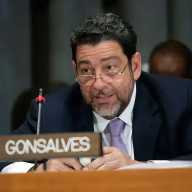Having made what has been considered a strong recovery from the global financial crisis of 2009, the World Bank says economic activity in Latin America and the Caribbean is once again facing external and domestic headwinds.
The Washington-based financial institution said overall growth in the region eased to 4.3 percent in 2011, from a remarkable 6.1 percent post-crisis rebound in 2010.
In the Caribbean, the World Bank said growth was supported by “a continued, albeit subdued, recovery in tourism, and a notable increase in activity in the mining and extractive sectors.
“Increased concerns about the worsening of the situation in the Euro area during May has caused market sentiment to deteriorate globally,” it bank said.
“Increased financial tensions have driven up the price of risk, caused most currencies to depreciate against the US dollar, and caused commodity prices and stock market indexes to decline markedly,” it added.
“This is in contrast to developments in early 2012, when improved sentiment in high-income Europe and the associated improvements in market expectations had prompted a robust rebound in capital flows, equity markets and regional currencies,” the bank continued.
It said the short-term outlook for Latin America and the Caribbean is clouded by a “fragile and uncertain external environment, still high oil prices and capacity constraints in select economies.
“Due to resurgence in tensions in the high-income world, the region is once again facing headwinds from marked declines in commodity prices and weaker capital flows,” the bank said.
The bank said growth in the Caribbean is expected to consolidate at 4 percent by 2014, due, in part, to improvements in labor markets in the United States.
It said the expected gradual recovery in the United States bodes well for Mexico, Costa Rica, El Salvador, and Haiti – countries that have strong industrial links to the world’s largest economy.
The recovery will also support remittances and tourism to Central America and the Caribbean, the bank said.
It said risks to growth in the region have shifted to the downside, stating that large fiscal deficits and public debts in high-income countries and very loose monetary policies “suggest that capital flows will remain volatile in the next years, making the fine-tuning of macroeconomic policies challenging.”
The World Bank said sharp deterioration of conditions in the Euro area is one of the main risks to the Latin American and Caribbean economies.
It said in such a scenario, global demand could drop significantly, and commodity prices, remittances, tourism, finance, and consumer and business sentiment would be negatively affected, potentially causing regional output to decline relative to baseline by close to 4 percent.
“Countries that have fewer macroeconomic buffers could be particularly vulnerable in the face of a significant weakening in global demand,” it said.



























